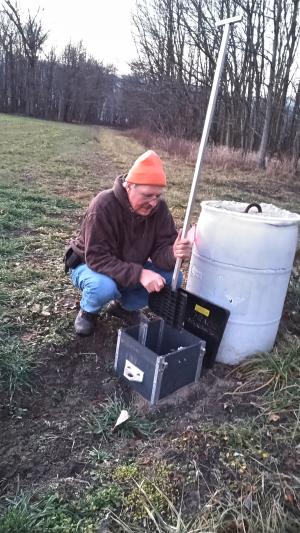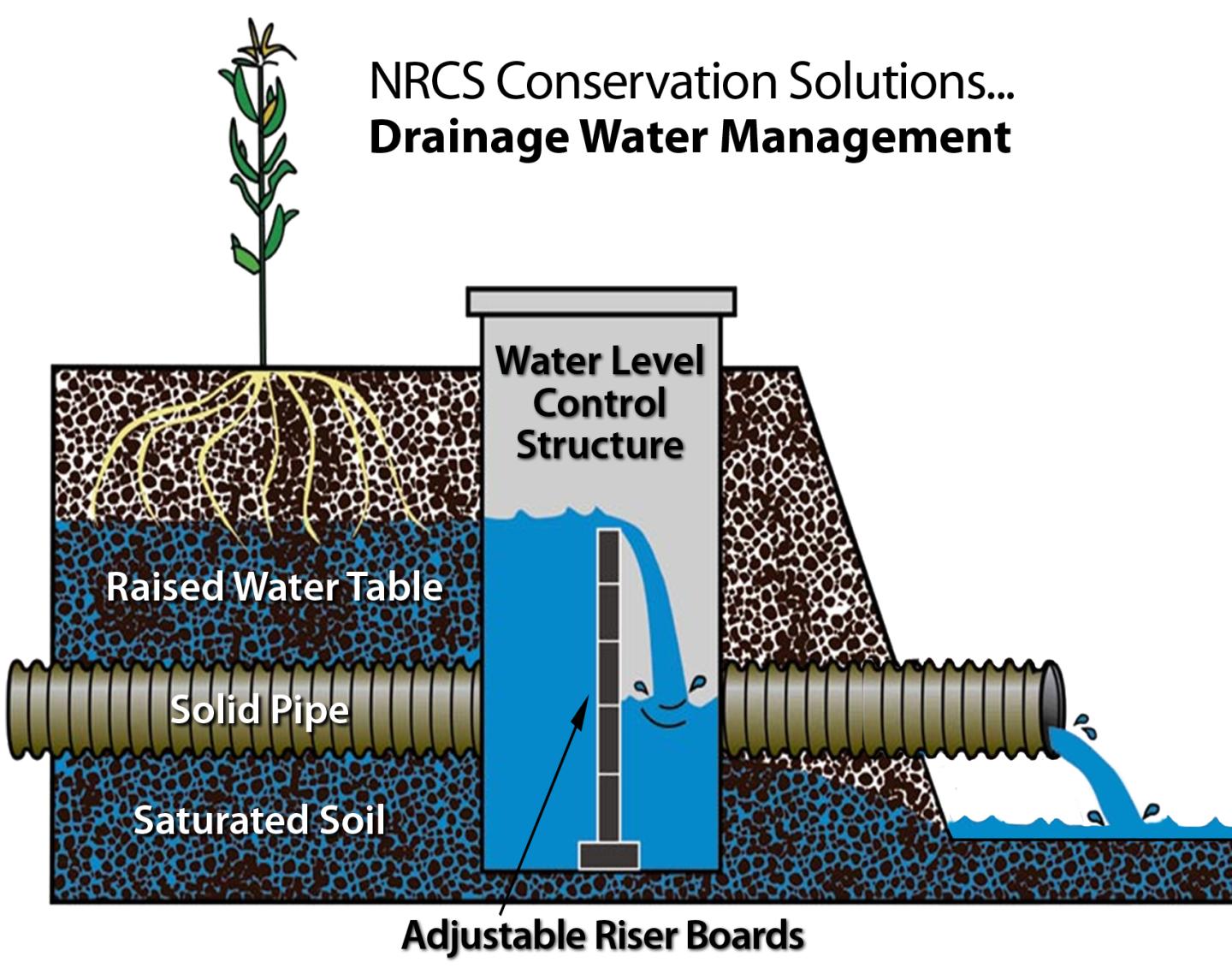Water Management System Helps Critical Watershed in Indiana

Since he started farming in the late 1970s, Michael G. Werling has worked with the USDA Natural Resources Conservation Service (NRCS) to implement almost every conservation practice applicable to his land.
Since he started farming in the late 1970s, Michael G. Werling has worked with the USDA Natural Resources Conservation Service (NRCS) to implement almost every conservation practice applicable to his land. He no-tills his fields and plants cover crops in-between cash crop seasons. He’s installed a two-stage ditch and filter strips to help manage nutrient runoff. He has also enrolled some of his land into the USDA Farm Service Agency’s Conservation Reserve Program (CRP), installing grass waterways and planting pollinator habitats throughout his operation.
At first the decision to implement the practices was purely practical. He had some erosion issues on his land and wanted to preserve his soil. But as the years have passed, the purpose has changed from a desire to improve his operation, to a sense of duty to protect the environment around his farm.

That desire led him to work with his district conservationist and an NRCS engineer to install two drainage water management structures on a 36-acre parcel that is part of his farm. Although the structures have been shown to have the potential to offer some yield benefits, when asked why he pursued installing them, Werling’s answer had nothing to do with profits, yields or even his own farm.
“It's the right thing to do,” he said. “Do I have to say more than that? It's the right thing. So, I do it.”
Werling’s farm is part of the St. Mary’s River watershed near Decatur, Indiana in Adams County. The river joins with the St. Joe River to form the Maumee River, which eventually drains into Lake Erie. As water flows from Werling’s farm and others in the watershed, it has the potential to carry runoff nutrients and sediment to nearby waterbodies. The excess nitrogen and phosphorous can end up in the lake polluting it and causing harmful algae blooms and other disturbances.
It was a desire to lessen his contribution to that pollution that Werling said led him to contact the NRCS and inquire about installing a drainage water management structure on his land. The structure enables him to trap water in his fields instead of allowing it to drain freely through the tiles and into the watershed. As the water sits there in the fields, excess nitrogen is displaced making the eventual outflow of water less harmful to the water system it will join.
The project on Werling’s farm required the NRCS to reroute his existing tiles into two drainage water management structures before allowing the water to flow into the two country tiles that run through his farm. The structures are boxes placed in the ground that allow Werling to adjust how much water flows through the system at any given time.
By adding or removing boards in the box, Werling raises and lowers the water table. When all the boards are in place, the water is almost completely trapped upstream and very little can drain through his tiles into the county line. When all the boards are removed, the water flows freely. He can also adjust the level to variable stages in between. Adjusting the flow raises and lowers the water table in the soil profile, which the plants can use during dry spells. The soil can also filter excess nutrients out of the water while it sits trapped in the soil profile.
“The idea is let's plug that tile and keep the water in the ground and upstream,” said Andrew Pursifull, the NRCS area engineer for Indiana’s northeast area, who worked with Werling to install the structures. “And at that point the water denitrifies. It either goes into deep percolation and gets filtered out or a lot of that nitrogen denitrifies right to the atmosphere … If you reduce the tile flow 50%, then we basically reduce the nitrogen load 50% going into the stream where the tiles outlet.”
At the bare minimum the structures have to be managed twice a year, Pursifull said. After harvest season in the fall the boards are put in, trapping water during the fallow season when runoff is the worst. Then in the spring, the boards are taken back out to allow the field to drain for planting. A more hands-on approach can also be taken, he said, and the water table can be elevated after planting to trap some water in the field through the summer. That practice protects the farmer some if the summer is very dry. Trapping water through the summer has been shown to have some yield benefits for farmers, Pursifull said, but the main benefit of the structures is the water quality impact they have by reducing nutrient runoff.
Because of the water quality benefits of the drainage water management structures, and the location of his farm, Werling was able to qualify for funding through the Great Lakes Restoration Initiative (GLRI) in order to install the two structures on his land. GLRI is a subset of the Environmental Quality Incentives Program (EQIP) and provides financial and technical assistance to private landowners whose land drains into priority watersheds having a negative impact on the water quality in the Great Lakes. Through the St. Mary’s River, Werling’s farm drains into the Western Lake Erie Basin, which has been targeted for improvement by GLRI.

“I probably wouldn't have done it without cost share, because it was a little expensive to lay all those tile connections,” Werling said. “It probably wouldn't have happened without it.”
Werling plants a three-year rotation of corn, soybeans and oats on his farm. Because of the construction required to install the structure, it was determined that undertaking the project in an oat year was best as the crop is harvested earlier and the construction could be completed during the summer dry season. The two boxes were completed in September and Werling said he currently has the boards placed all the way to the top, cutting off the flow through the tiles. Following the recent rains, he said he will likely need to go out and let some water drain before harvesting the last of his corn. In all, the two boxes control the flow of water on about 30 of the 36 acres in the field where they were installed.
“It takes five minutes to change the level of the water in there,” Werling said. “You open up the top of the box and reach in there with the handle and either (put them) down or pull them up. So, it is a management. I have to go out and do that, but it's not a problem. It's a good thing to look at your fields anyway to know where you're at. Management's always a good thing for a field.”
Additional Information
GREAT LAKES RESTORATION INITIATIVE
NRCS, through the GLRI, targets watersheds that are expected to have the greatest impacts on improving water quality. GLRI funds are targeted to these Priority Watersheds to implement avoiding, controlling and trapping practices that reduce the amount of nutrient loss from agricultural lands.
INDIANA ENVIRONMENTAL QUALITY INCENTIVES PROGRAM
The Environmental Quality Incentives Program (EQIP) provides financial and technical assistance to agricultural producers and non-industrial forest managers to conserve natural resources while strengthening their operations.
Indiana NRCS Homepage
For more information about NRCS programs offered in Indiana and how experts throughout the state can help you address natural resource concerns on your land, visit the Indiana NRCS homepage.

